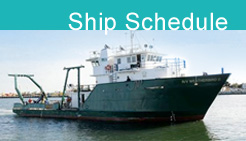Deep Sea Fish and Sediment Surveys in the Gulf
Still enroute…
Posted by K.Bylsma, C-IMAGE Teachers at Sea for August 6, 2013

Now 2:15pm on August 6. The trip to our first test site takes A LONG time. I’m sitting in the galley, where the cook, Thomas Lee works to prepare each and every meal for the 23 people- scientists and crew aboard. Although not a member of the scientist’s crew, his duties are at least as important. He lives in Seminole with his family and is at sea for months at a time, depending on the voyage agendas.
The Assistant Engineer is also in the galley at the moment. His resume includes many engineering related jobs in and around the Hudson area of Pasco County. Anything breaks, or acts out of the normal, then he’s your man!
I truly enjoyed my discussion with the Lead Scientist, Heather Broadbent. She reports to Kendra Daly at USF on this C-IMAGE project, but she also has had the opportunity to collect data in Antarctica. Understanding how research takes place is fascinating. Being receptive, open and willing seems to be the undercurrent. Ms. Broadbent’s field of study at USF is designing sensors. She had wanted to collect data from penguins and turtles. A grant was awarded to Ms. Daly’s department for Antarctic research. Ms. Daly will return to the most southern continent in November without her dogs and husband, the printer, after the C-IMAGE project this fall.
Then, I was chatting with Jonelle, I learned so much more about how research is conducted. She has been working in a microbiology lab at USF each Spring. She is responsible for setting up, scoring , and clean up for nearly 40 students during the Spring semester. That’s a busy time for her. The rest of the year, though, she can take advantage of other opportunities…. Which is how she learned about the C-IMAGE outings. As a lab technician, she had proven her abilities and was recommended for several opportunities. Right place at the right time and WILLING! ( all the while I was listening to these trained scientists , I thought about several students, in particular, who I would have recommended for this type of learning experience—- and they were only in the eighth grade .
One of the most intricate pieces of equipment on this vessel is the CTD- measuring conductivity, temperature and density. ( see illustration). 
At various depths throughout the voyage, the CTD gets “deployed” . The lids on each Niskin bottle are locked by the computer that Andrew Warren mans. This way, the individual tests can be run on each sample – dissolved oxygen, alkalinity, pH, nitrates, phosphates, carbon dioxide. This is the hub of what we are collecting during this trip.
Kat Ternus is a Marine Biology Undergraduate at University of Miami. Since she studies light/ dark photosynthetic reactions in copepods – zooplankton. She has explained to me that she uses the CTD for her sampling, but only at certain depths , but at dusk and dawn, then fixes them for studying later, at UM. She wants to know about the populations of certain zooplankton as a result of the DWH event.
These are the resources that I found to help students understand what they are looking at on slides.
Teachers:
I spent a fair amount of time researching marine life. Although I downloaded a marine microbes chapter of a high school text, I tended to use the visuals from Enchanted Learning. They offered a variety of samples for young students, into middle school because of the taxonomy piece. Concepts related to symmetry, anatomy, and relative size are helpful. You would also have to know which layers of the ocean each of the organisms traditionally inhabits and under what conditions. These Bongo nets are the tools used to capture these foramina ( living things)

Students :
* Has there been a shift in the numbers of different species of microbes? Why?
* Since you have read the post regarding the history of the DWH spill, you know that the spill occurred deep in the Gulf as opposed to having “ spilled” from a container vehicle into the open waters. Since the spill occurred three years ago, now, what has been the impact on both water chemistry and the resultant organisms? We all know what the immediate impact was on Florida, Louisiana, Alabama, and Mississippi.
** What is the impact on fish that you might have been catching this summer?
** If you were swimming in the Gulf, might you anticipate any adverse health effects?
| Print article | This entry was posted by greely on August 6, 2013 at 1:30 pm, and is filed under Oceanic Updates. Follow any responses to this post through RSS 2.0. You can leave a response or trackback from your own site. |

